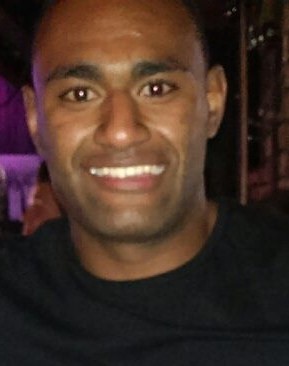The Fiji national rugby league team, nicknamed the Bati, has been participating in international rugby league football since 1992. The team is controlled by the governing body for rugby league in Fiji, Fiji National Rugby League (FNRL), which is currently a member of the Asia-Pacific Rugby League Confederation (APRLC). Fiji have thrice reached the semi-finals of the Rugby League World Cup, in 2008, 2013 and 2017, and are currently ranked 6th in the International Rugby League's World Rankings. They are coached by Fijian Wise Kativerata, and their captain is Tui Kamikamica. The team will typically perform the hymn "Noqu Masu" before each match, singing in unison.
Ratu Kadavulevu School is a school in Lodoni, Fiji. It has some 1000 boarding students and 100 dayscholar students and is the largest boarding schools in the South Pacific Region. Its students are multiracial, but predominantly indigenous Fijians.

Sigatoka is a town in Fiji. It is on the island of Viti Levu at the mouth of the Sigatoka River, for which it is named, some 61 kilometres from Nadi. Its population at the 2017 census was 17,622. It is the principal urban centre for the province of Nadroga-Navosa.

Nadroga-Navosa is one of the fourteen provinces of Fiji and one of eight based in Viti Levu, Fiji's largest island. It is about 2,385 square kilometers and occupies the South-West and Central areas of Viti Levu, Fiji's principal island. The province includes the Mamanuca Archipelago,Malolo Islands, off the west coast of Viti Levu, Vatulele, as well as the remote Conway Reef in the southwest. The population at the 2017 census was 58,931, being the fifth largest province. The main town in Nadroga-Navosa is Sigatoka, with a population of 9622.

Lote Daulako Tuqiri is a former professional dual-code rugby footballer who primarily played as a winger across both codes. He represented Australia in both rugby league and rugby union, and Fiji in rugby league. Tuqiri first rose to prominence as a professional rugby league footballer for the Brisbane Broncos and Queensland Maroons, as well as the Fiji and Australia national sides. He was therefore a high-profile signing for rugby union in 2002, winning 67 caps for Australia and being a part of their 2003 and 2007 World Cup squads. He played rugby union for the Waratahs in the Super 14 and Leicester Tigers in England in season 2009–10. Tuqiri's contract with the Australian Rugby Union was terminated on 1 July 2009. No immediate reason was given, and Tuqiri returned to rugby league in 2010, playing for the Wests Tigers of the NRL. In September 2013, he signed a short-term contract with Irish rugby union giants, Leinster to play in the Pro12 in a three-month deal. Just 6 weeks out from the 2014 NRL season, Tuqiri signed with his third NRL club, the South Sydney Rabbitohs, on a one-year deal.

Noa Nadruku is a Fijian former rugby footballer who played in the 1980s and 1990s. After representing Fiji in rugby union, he switched to play rugby league in Australia for the Canberra Raiders and was named as one of the best 25 players for the Raiders' 25-year anniversary.
Rugby union is the most popular sport in Fiji ; however, rugby league, netball, and association football are also widely played. Various forms of traditional boat racing and wrestling are also popular.

Nemani Nadolo is a Fijian-Australian former rugby union player. He most recently played for the New South Wales Waratahs in Super Rugby, usually as a wing or centre, and the Fiji national team.

Fijian Australians refers to Australian citizens or residents of Australia who are of ethnic iTaukei or Indian descent. Most Fijians Australians live in New South Wales (Sydney), Queensland (Brisbane) and Victoria (Melbourne).
Lote Tuqiri is a Japan international rugby union sevens player.

Tevita Kuridrani is a Fijian-born Australian rugby union player. His usual position is outside-centre. He is currently with French club Biarritz and previously played for the Brumbies and Western Force in Super Rugby. Kuridrani has sixty caps for Australia in international rugby.
The Fiji national under 20 rugby team is for Fijian rugby union players aged 20 or under on January 1 of the year during which they are selected.
The 2005 Wallabies spring tour was a series of five matches played by the Australia national rugby union team in November 2005.

Kirisi Kuridrani, formerly Kirisi Nasiganiyavi, is an Australian rugby union player of Fijian descent. He is currently signed to Japanese club Honda Heat and previously played for the Queensland Reds in Super Rugby. His usual position is wing.
The 2013 Australia national rugby union team tour of Great Britain, Ireland and Italy was a rugby union tour between the away team Australia and the homes teams of England, Ireland, Italy, Scotland and Wales. They also played an additional Test match against New Zealand, which acted as the third and final Bledisloe Cup match for 2013.
Iliseva Batibasaga is a former Fijian-Australian rugby union player. She represented Australia in 27 tests between 2006 and 2022.

Amenoni Nasilasila is a Fijian rugby union footballer. He had played for the Fiji sevens team. Nasilasila made his debut for Fiji 7s at the 2014 Dubai Sevens.
Elia Tuqiri is former professional rugby league and rugby union player who played for the Brisbane Broncos and NSW Waratahs. He is the cousin of dual international Lote Tuqiri, Fijian international winger Nemani Nadolo and Wallabies centre Tevita Kuridrani. They all hail from one of the most famous rugby nurseries in Fiji, Namatakula Village.
Emosi Tuqiri is a Fijian rugby union player, currently playing for the Drua. His preferred position is prop.









